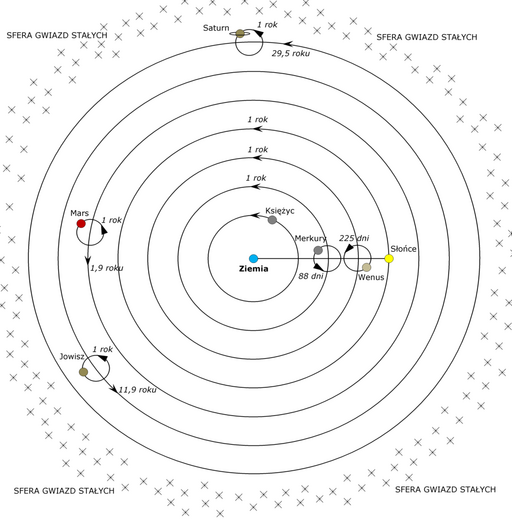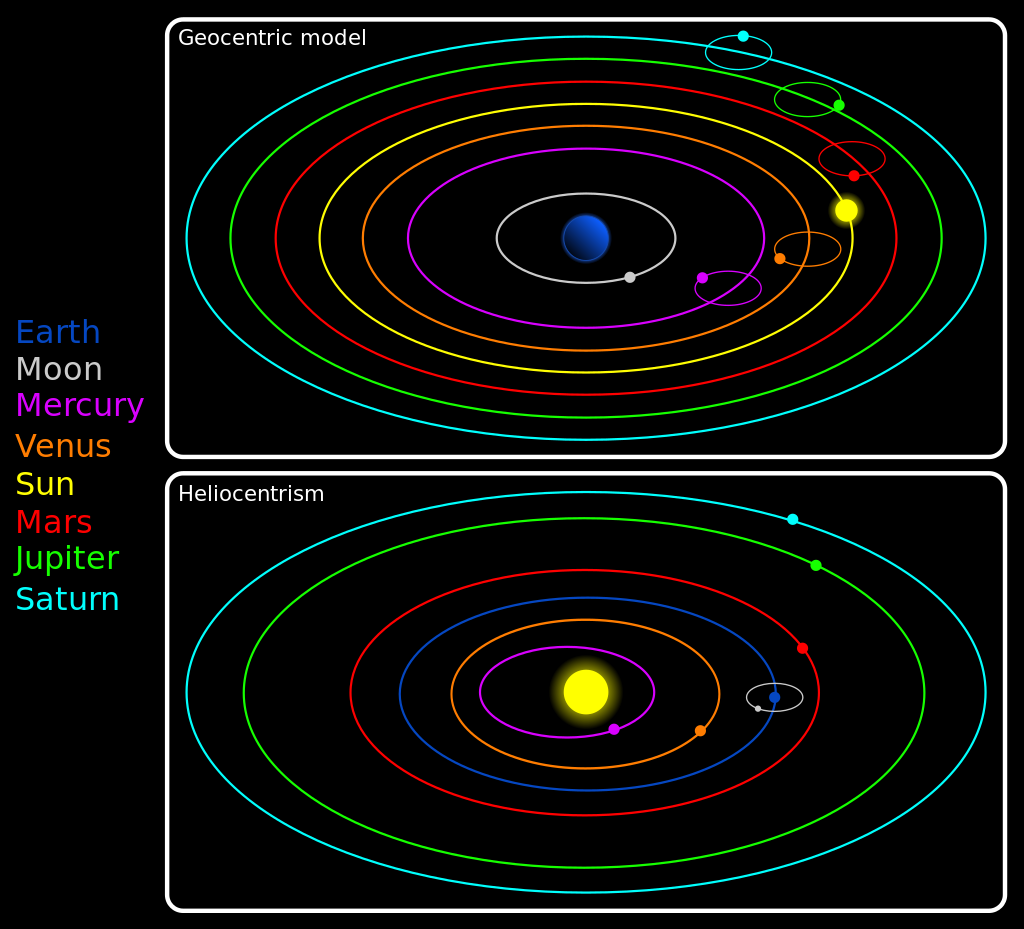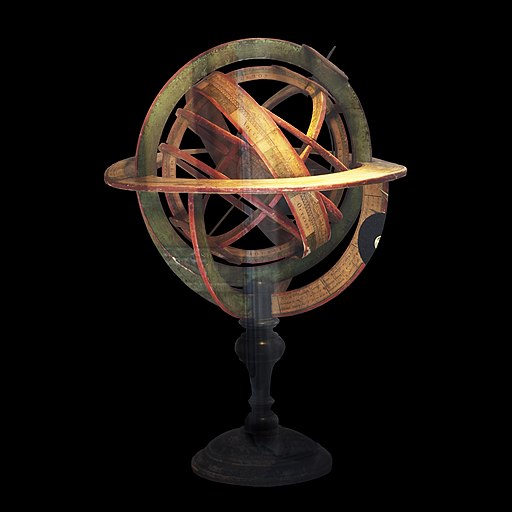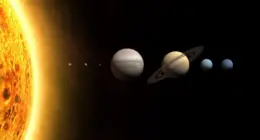The Geocentric and Heliocentric models are two contrasting theories that attempt to explain the relationship between the Earth, the Sun, and other celestial bodies.
TL;DR Geocentric Vs. Heliocentric
Geocentric: Geocentrism is the belief that the Earth is the center of the universe, with celestial bodies orbiting it. This ancient model, held by early astronomers like Ptolemy, positioned Earth as the stationary focal point and attempted to explain the motion of planets and stars by intricate epicycles.
Heliocentric: Heliocentrism is the modern understanding that the Sun is at the center of our solar system, and planets, including Earth, orbit around it. This revolutionary concept, proposed by Copernicus and later supported by Galileo and Kepler, correctly describes the motions of celestial bodies and formed the foundation of modern astronomy.
What is the Geocentric Model?

The Geocentric model, which dates back to ancient times, believed that the Earth was at the center of the universe, with the Sun, planets, and stars revolving around it. Explored in the historical background section, this theory was widely accepted and influential in ancient cultures.
Historical Background of Geocentric Model
The historical background of the geocentric model dates back to ancient times when early civilizations observed the motion of celestial bodies in the sky. The geocentric model, also known as the Ptolemaic system, proposed that Earth was the center of the universe, with all other celestial bodies revolving around it.
One of the earliest recorded references to the historical background of the geocentric model can be traced back to ancient Greek civilization, particularly to the work of philosopher Aristotle and astronomer Ptolemy. They believed that the Earth was stationary and located at the center of the universe, with the Sun, Moon, planets, and stars all rotating around it in perfect circles.
This historical background of the geocentric model was widely accepted and influential for centuries, as it provided a simple and intuitive explanation for the observed motions of the celestial bodies. It was deeply rooted in religious and philosophical beliefs, as it seemed to align with the idea of Earth being the most important and special place in the universe.
It wasn’t until the 16th century that this historical background of the geocentric model was challenged by the heliocentric model proposed by Nicolaus Copernicus. Copernicus suggested that the Sun, not Earth, was at the center of the solar system, and that the planets, including Earth, orbited around it.
The historical background of the geocentric model highlights the development of human understanding of the universe and the gradual shift from an Earth-centered worldview to a Sun-centered one. It represents a significant milestone in the historical background of the geocentric model and our understanding of the cosmos.
The historical background of the geocentric model reveals the prevailing belief in ancient civilizations that Earth was the center of the universe. This perspective was eventually challenged by the heliocentric model proposed by Copernicus, leading to a fundamental shift in our understanding of the universe and our place in it.
Key Features of the Geocentric Model
The key features of the Geocentric Model highlight the belief that Earth occupies a special position in the cosmos and that all celestial bodies revolve around it. This model dominated scientific and philosophical thought for centuries until the advancements made by astronomers like Nicolaus Copernicus, who proposed the Heliocentric Model.
History has shown how the Geocentric Model, with its emphasis on Earth’s central position, influenced the understanding of the universe. It shaped the way ancient cultures, like the Ancient Greeks and Egyptians, perceived and studied celestial phenomena. With further observations and scientific breakthroughs, the Geocentric Model eventually gave way to the Heliocentric Model, which places the Sun at the center of the Solar System. The transition from the Geocentric to the Heliocentric Model revolutionized our understanding of the universe and paved the way for modern astronomy.
The key features of the Geocentric Model can be summarized in the following table:
| Feature | Description |
|---|---|
| Earth as the center | According to the Geocentric Model, the Earth is believed to be the center of the universe. |
| Fixed celestial sphere | The stars, planets, and other celestial bodies are thought to be fixed on a celestial sphere that revolves around Earth. |
| Epicycles | To explain the movements of planets, the Geocentric Model incorporated the concept of epicycles, or small circles within the larger celestial orbits. |
| Retrograde motion | The Geocentric Model accounted for the observation of planets appearing to move backward (retrograde motion) in the night sky. |
| Geocentric cosmology | This model aligned with the prevailing cosmological beliefs of ancient cultures, including the Ancient Greeks and Egyptians, who viewed Earth as the center of the universe. |
Geocentric Model in Ancient Cultures
The belief in the geocentric model was deeply ingrained in ancient cultures’ perception of the world and the universe. These civilizations, including the Egyptians, Greeks, and Babylonians, embraced this model as the foundation of their understanding.
In ancient Egypt, the geocentric model held significant religious significance. The Egyptians believed that the Pharaoh served as a connection between gods and humans, and the hierarchical structure was reflected in their view of the universe. They even aligned their temple complexes with astronomical phenomena, further solidifying their geocentric worldview.
The ancient Greeks, particularly influential philosophers such as Aristotle and Ptolemy, developed intricate mathematical models and theories to explain the movements of celestial bodies within the geocentric framework. They firmly held the belief that Earth remained stationary at the center, while the celestial spheres, including the sun, moon, and planets, revolved around it in complex circular motions.
Likewise, the Babylonians, renowned for their advanced knowledge of astronomy, also adhered to the geocentric model. They meticulously observed celestial events and utilized them to predict future astronomical occurrences and establish calendar systems.
The geocentric model served as the cornerstone of ancient cultures’ comprehension of the cosmos, leaving a profound impact on their religious, philosophical, and scientific beliefs. Although the heliocentric model has since replaced it, studying the prevalence of the geocentric model in ancient cultures provides valuable insights into the development of human knowledge and the evolution of scientific thought.
What is the Heliocentric Model?

Contrasting the Geocentric model, the Heliocentric model, introduced by Nicolaus Copernicus in the 16th century, proposes that the Sun is at the center and the Earth and other planets orbit around it. The historical background of the Heliocentric model will be explored, highlighting Copernicus’ contributions and the revolutionary shift in understanding.
Historical Background of Heliocentric Model
The historical background of the heliocentric model, known as the Copernican system, can be traced back to ancient Greek astronomers. It was Aristarchus of Samos in the 3rd century BCE who first proposed that the Earth revolved around the Sun, challenging the prevailing geocentric model.
However, it wasn’t until the 16th century that the heliocentric model gained significant attention with the work of Nicolaus Copernicus. Copernicus developed a comprehensive mathematical model of the solar system, placing the Sun at the center and the planets, including the Earth, orbiting around it.
This groundbreaking model challenged the long-held belief of the Earth being stationary at the center of the universe. For centuries, the geocentric model had been accepted based on observations made by ancient astronomers and religious beliefs.
The heliocentric model received further support in the early 17th century through the work of Galileo Galilei. Using a telescope, Galileo made groundbreaking observations that provided evidence in favor of the heliocentric model, contradicting the geocentric model.
The historical background of the heliocentric model represents a gradual shift in scientific understanding and the acceptance of the Earth’s position in the universe. This shift has played a significant role in shaping our modern understanding of the solar system and our place within it.
Key Features of the Heliocentric Model
- The key features of the heliocentric model include the concept that the Sun is at the center of the solar system, serving as the central point around which all other celestial bodies, including the Earth, orbit.
- According to the heliocentric model, the planets in our solar system, including the Earth, have elliptical orbits around the Sun. This differs from the geocentric model, which believed the planets moved in circular orbits around the Earth.
- Another significant feature of the heliocentric model is that the planets, including the Earth, move at varying speeds in their orbits around the Sun. This challenges the geocentric model that proposed uniform speeds for the planets.
- In the heliocentric model, the planets, including the Earth, have inclined orbits in relation to each other. This means that their paths are not on the same plane but are tilted at different angles. This concept helps explain the changing positions of the planets in the sky.
- The heliocentric model suggests that the Earth rotates on its axis, causing the apparent rising and setting of the Sun and other celestial bodies. This rotation helps explain the phenomena of day and night.
- One of the key features of the heliocentric model is its ability to explain the phenomenon of retrograde motion observed in the motion of planets. Retrograde motion refers to the apparent backward movement of a planet in the sky. The heliocentric model explains this as a result of the varying speeds and positions of the planets in their orbits.
Contributions of Nicolaus Copernicus
Nicolaus Copernicus made significant contributions to the understanding of the heliocentric model of the solar system. Here are some key aspects of his contributions:
| 1. | Copernicus proposed that the Sun, rather than the Earth, is at the center of the solar system. |
| 2. | He formulated a mathematical model, known as the Copernican model, that explained the movements of the planets more accurately than the geocentric model. |
| 3. | Copernicus’s model emphasized the idea of a heliocentric universe, where the Earth and other planets revolve around the Sun in circular orbits. |
| 4. | His work challenged the prevailing geocentric view of the universe, which was based on the belief that the Earth was stationary and at the center of all celestial motion. |
| 5. | Copernicus’s contributions laid the foundation for future advancements in astronomy and paved the way for the scientific revolution. |
One fascinating anecdote about Copernicus is that he made significant contributions to the understanding of the heliocentric model of the solar system. He proposed that the Sun, rather than the Earth, is at the center of the solar system. Additionally, Copernicus formulated a mathematical model, known as the Copernican model, that explained the movements of the planets more accurately than the geocentric model. His model emphasized the idea of a heliocentric universe, where the Earth and other planets revolve around the Sun in circular orbits. Moreover, his work challenged the prevailing geocentric view of the universe, which was based on the belief that the Earth was stationary and at the center of all celestial motion. These contributions laid the foundation for future advancements in astronomy and paved the way for the scientific revolution.
With encouragement from his colleagues and the support of prominent astronomers, Nicolaus Copernicus eventually published his groundbreaking work, “De Revolutionibus Orbium Coelestium,” in 1543. This publication revolutionized the understanding of the universe and set the stage for the advancement of scientific knowledge in the centuries to come.
Comparison between Geocentric and Heliocentric Models
Did you know that the way we perceive the position of celestial bodies has evolved over centuries? In this fascinating comparison, we’ll delve into the contrasting geocentric and heliocentric models. From the basis of each model to the positions of Earth and other celestial bodies, we’ll uncover the explanatory power and historical significance behind these theories. Get ready to embark on a celestial journey that will challenge your understanding of the universe.
Basis of the Model
The basis of the model, which can be understood by comparing the geocentric and heliocentric models, is fundamental to our understanding of the universe.
| Geocentric Model | Heliocentric Model |
| The Earth is considered to be the center of the universe. | The Sun is considered to be the center of the universe. |
| The other celestial bodies, such as the moon, planets, and stars, revolve around the Earth in circular orbits. | The other celestial bodies, including the Earth, revolve around the Sun in elliptical orbits. |
| This model suggests that the Earth is stationary and does not move. | This model proposes that the Earth rotates on its axis and orbits the Sun. |
The geocentric model, once widely accepted, was based on both observational evidence and philosophical beliefs. It was supported by the belief in the special position of the Earth, which was considered the center of the universe.
On the other hand, the heliocentric model, proposed by Nicolaus Copernicus, challenged the geocentric model by providing a simpler explanation of celestial body motion. It emphasized that the Earth is just one of many planets orbiting the Sun, which is the center of our solar system.
The basis of the model refers to the central concept or principle upon which the entire model is built. In the geocentric model, the basis lies in the belief that the Earth is at the center of the universe. However, in the heliocentric model, the basis is the understanding that the Sun is at the center.
By understanding the basis of each model, we can recognize the fundamental differences and grasp the significance of the shift from the geocentric to the heliocentric model in our understanding of the universe.
Position of Earth and Other Celestial Bodies
The position of Earth and other celestial bodies is a crucial aspect when comparing the geocentric and heliocentric models. In the geocentric model, Earth is believed to be at the center of the universe, with the Sun, Moon, planets, and stars revolving around it. This implies that the position of Earth is stationary, while the other celestial bodies move in complex patterns.
On the other hand, the heliocentric model places the Sun at the center of the solar system, with Earth and other planets orbiting around it. This means that Earth is in motion, revolving around the Sun along with other celestial bodies.
In terms of the position of other celestial bodies, the geocentric model suggests that their movements can be explained by complex combinations of circles and epicycles. This model implies that the planets and stars have intricate paths as they traverse the sky.
In contrast, the heliocentric model simplifies the explanation of celestial bodies’ positions by proposing that their movements can be understood based on elliptical orbits around the Sun. This model provides a more straightforward and elegant explanation for the positions and motions of Earth and other celestial bodies.
The geocentric and heliocentric models present contrasting perspectives on the position of Earth and other celestial bodies, with the geocentric model placing Earth at the center and the heliocentric model positioning the Sun at the center.
Explanatory Power
The explanatory power of a scientific model, which refers to its ability to provide a comprehensive and accurate explanation of observed phenomena, is a crucial factor when comparing the geocentric and heliocentric models.
The geocentric model, which placed Earth at the center of the universe, had limited explanatory power. It struggled to account for the retrograde motion of planets and the varying brightness of celestial bodies. This model relied on complex systems of epicycles to explain these observations, but it became increasingly convoluted and lacked simplicity, ultimately hindering its ability to provide a comprehensive and accurate explanation.
On the other hand, the heliocentric model, proposed by Nicolaus Copernicus, offered a more elegant and powerful explanation. By placing the Sun at the center of the solar system, it accurately explained the retrograde motion of planets and simplified the understanding of celestial phenomena. The heliocentric model provided a better framework for predicting the positions and motions of celestial bodies, thus demonstrating its superior explanatory power.
In terms of explanatory power, the heliocentric model revolutionized our understanding of the universe and laid the foundation for modern astronomy. It not only explained the observed phenomena more accurately but also paved the way for further scientific discoveries and advancements. Therefore, when evaluating the explanatory power of the geocentric and heliocentric models, it becomes evident that the heliocentric model surpasses the geocentric model in its ability to provide a comprehensive and accurate explanation of celestial phenomena.
Historical Significance
The historical significance of the geocentric and heliocentric models cannot be overstated. Before the acceptance of the heliocentric model, the geocentric model held significant cultural and religious implications and was the prevailing belief for centuries, shaping the way people viewed their place in the universe.
One notable example of the historical significance is the influential role of the geocentric model in ancient cultures. Civilizations like the Babylonians and Egyptians developed intricate astrological systems based on the belief in the historical significance of the Earth being at the center of the universe. These systems influenced various aspects of their societies, including agriculture, rituals, and governance.
The introduction of the heliocentric model by Nicolaus Copernicus in the 16th century challenged the long-held views of the geocentric model, bringing about a paradigm shift in scientific thinking. This breakthrough had historical significance and revolutionized our understanding of the universe, paving the way for advancements in astronomy, physics, and mathematics. It also led to the discoveries and theories of scientists like Galileo Galilei and Isaac Newton.
The historical significance of the transition from the geocentric to the heliocentric model cannot be understated. This shift not only transformed our scientific understanding of the universe but also had profound cultural, religious, and societal impacts. It demonstrates the power of scientific progress, continuously shaping our understanding of the world and challenging long-held beliefs.
One notable example of the historical significance of this transition is the trial of Galileo Galilei in 1633. Galileo’s support for the heliocentric model challenged the authority of the Catholic Church, which considered the geocentric model as a fundamental belief. Galileo’s trial and subsequent house arrest symbolized the clash between science and religion, highlighting the power of ideas and the resistance to change in the face of established beliefs. Galileo’s perseverance in advocating for the truth and his contributions to advancing scientific knowledge are a testament to the historical significance of the heliocentric model.
Modern Understanding and Acceptance
In modern scientific understanding, the difference between geocentric and heliocentric models refers to how we perceive the motion of celestial bodies, particularly the Earth and the Sun.
Geocentric Model:
The geocentric model, which was widely accepted in ancient times, positioned the Earth at the center of the universe. According to this model, all celestial bodies, including the Sun, revolved around the Earth in circular orbits.
Heliocentric Model:
The heliocentric model, which gained acceptance in the 16th century, places the Sun at the center of the solar system. According to this model, the Earth and other planets orbit the Sun in elliptical paths.
Today, the heliocentric model is widely accepted and forms the foundation of our understanding of the solar system. This understanding is based on extensive scientific evidence, including observations, mathematical calculations, and advancements in astronomy and physics.
Key reasons for the modern acceptance of the heliocentric model include:
- Observations: Through telescopes and spacecraft, we have observed the motion of planets, their moons, and other celestial bodies. These observations support the heliocentric model, as they align with the predicted movements based on this model.
- Gravitational Laws: Our understanding of gravity, as described by Newton’s laws and later refined by Einstein’s theory of general relativity, helps explain the motion of celestial bodies within a heliocentric framework.
- Advancements in Technology: Technological advancements have allowed us to gather more precise measurements and data, enabling us to refine our understanding of the solar system. This data consistently supports the heliocentric model.
- Consistency with Other Celestial Phenomena: The heliocentric model provides a coherent explanation for various celestial phenomena, such as the seasons, phases of the Moon, and the behavior of comets and asteroids.
While geocentric models may have historical and cultural significance, the heliocentric model is the prevailing scientific framework for understanding the motions and interactions of celestial bodies in our solar system.
Frequently Asked Questions
What is the geocentric model?
The geocentric model describes Earth as the center of the Universe, with the Sun, moon, stars, and planets orbiting around it. This model was predominant in ancient civilizations and was developed based on observations made using the naked eye.
How does the heliocentric model differ from the geocentric model?
The key difference between the geocentric and heliocentric models is the placement of the center. The geocentric model places Earth at the center of the Universe, while the heliocentric model places the Sun at the center and suggests that planets revolve around it.
Who proposed the heliocentric theory?
The heliocentric theory was first proposed by Aristarchus of Samos in the 3rd century BC. However, it gained more support and a proper mathematical model was presented in the 16th century by Nicolaus Copernicus.
What were the advancements that supported the heliocentric theory?
The heliocentric theory gained more support with the advancement of technology, including the invention of the telescope by Galileo Galilei. Observations made using the telescope confirmed the heliocentric model. Additionally, Johannes Kepler introduced the concept of elliptical orbits, further supporting the heliocentric theory.
What did Edwin Hubble discover about the solar system?
Edwin Hubble discovered that the Sun is not the center of the solar system, but rather part of millions of galaxies. His observations using telescopes revolutionized our understanding of the Universe.
How does the present model of the solar system align with the heliocentric theory?
The present model of the solar system aligns with the heliocentric theory, where the Sun is placed at the center. This model considers Earth as the third planet from the Sun, and it rotates on its axis while the stars appear to move in the sky.
Image Credits
Featured Image By – Rama, Public domain, via Wikimedia Commons
Image 1 By – Grzegorz Petka, Public domain, via Wikimedia Commons
Image 2 By –








